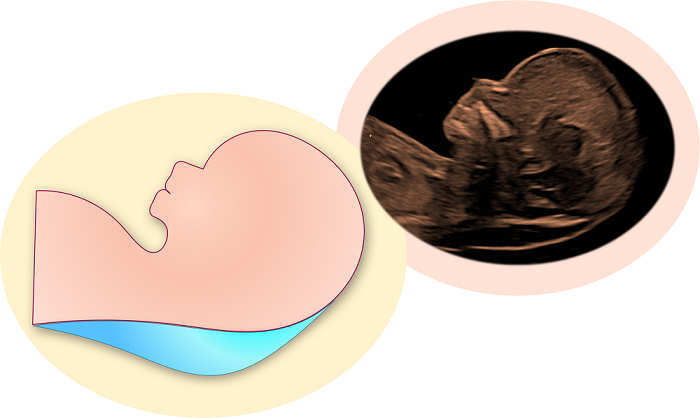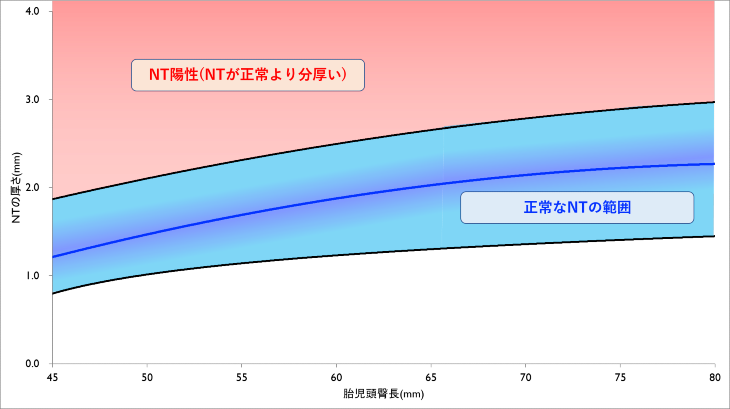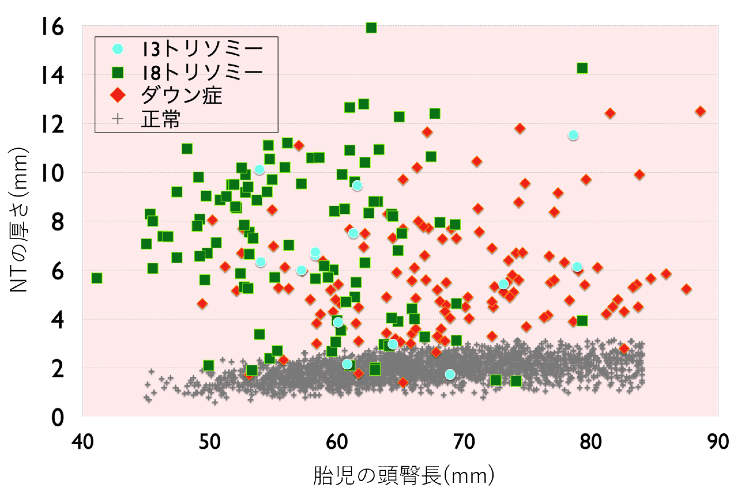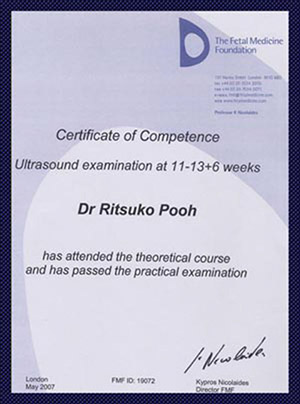What is NT?
What is NT?
- TOP
- Fetal Medicine
- What is NT?
About NT
What is NT?
NT is an acronym for Nuchal Translucency, which refers to the NT found in the back of the neck of babies around 11-13 weeks of pregnancy.
Even adults may have swollen feet after standing all day, or swollen face and hands the day after drinking alcohol. This is a physiological phenomenon in terms of bodily functions.
The presence or absence of NT is basically a misnomer; NT is present in all normal fetuses and gradually thickens with the number of weeks.
Therefore, NT in a fetus in early pregnancy is not necessarily a disease. Small fetuses in the early stages often have unstable circulation and are therefore more prone to NT.
How to test whether NT is pathological or not
To determine if NT is caused by a pathological condition, the whole body of the fetus needs to be examined.
At CRIFM, we offer “Early fetal Dock” in the first trimester of pregnancy (11-13 weeks). fetal Dock is a more detailed ultrasound examination than a prenatal checkup, and it allows us to clearly see the NT in fetuses as small as 4.5-8.4 cm.
For more information, please refer to the “fetal Dock” page.
After the results of the early fetal Dock and a thorough explanation of the risk of chromosomal abnormalities, patients who wish to have a chorionic villus sampling (CVS) performed on the same day can have the test done by inserting a syringe into the mother’s abdomen to collect villi.
Learn more about CVS / Amniocentesis
Is NT a sign of disease?
There have been many patients who have come to CRIFM crying, saying, “I was told my baby has NT during my prenatal checkup.
However, by explaining to them that NT is a physiological phenomenon that can be seen in any fetus, and that it is important to have a thorough examination to confirm whether it is pathological or not, they are able to receive an early fetal Dock calmly
Most of the time, thick NT is a temporary physiological phenomenon rather than a sign of disease, and although many patients are referred to CRIFM for NT tests, the NT disappears in most fetuses as they grow. NT alone does not mean fetal disease.
The fetus in the image had a thick NT, but the NT later faded and the baby was born safely. Baby has been growing well since then.

Moms and dads should consider that the fetus’s NT is a little thicker, which gives them more opportunity to face the fetus.
Is it safe to say that the NT will disappear?
The thick NT will disappear as the fetus grows.
This is due to the fetus’s amazing ability to adapt, allowing the blood and lymph to circulate better in that state, even if the fetus is sick.
In other words, if the NT disappears, it does not mean that the fetus is no longer susceptible to disease. For example, there are babies with Down’s syndrome or 18 trisomy whose NT is getting thinner.
It is also wrong to interpret that because NT is thin, it is not a problem. I will explain the reason for this with a diagram.

*Click image to enlarge
(Fig. 1) To begin with, the measurement of the NT requires a high degree of accuracy and a high level of skill. As shown in the figure, only the head and upper thorax of the fetus must fill the screen, and the nasal apex, nasal bones, and mesencephalon must be visible on the screen.
In order to accurately produce this screen, a great deal of training and experience is required, and qualified NTs from the FMF, which sets the standards for NT testing, are trained to produce this screen and are tested once a year to renew their qualification.*Click here to learn more about NT certification.

*Click image to enlarge
(Fig. 2)As the fetus grows, even normally, the NT also grows little by little. In this graph, the horizontal axis is the fetal head to buttock length (also called CRL) and the vertical axis is the size of the NT.The white line is the average NT size of a normal fetus and the red box is the normal NT range. The area in blue is NT positive, that is, the NT is thicker than normal.

*Click image to enlarge
(Fig. 3)As you can see from the graph, babies with Down syndrome, 18 trisomy and 13 trisomy have thick NT, but there are also fetuses with trisomy with normal NT.
Even if the NT is normal, the detection rate of trisomy is close to 100% by combining various ultrasound markers such as CRIFM.
Q & A about NT
Dr. Pooh will explain about “NT”, which is often heard in prenatal diagnosis, in an easy-to-understand Q & A format.
Q1: Does NT mean that the fetus is sick?
A. No, it does not. Please don’t worry.
NT is found in all fetuses. Even in normal fetuses, the NT gradually thickens as the fetus grows.
Q2: Does a thick NT indicate Down syndrome?
A. NT does not mean Down syndrome.
It is true that a thicker NT increases the possibility of Down syndrome, but there are many babies born with a 5mm or more NT who are free of the disease. In general, it is not possible to determine illness based on the thickness of the NT alone.
Q3. If the NT is normal, is there any disease?
A. There are some diseases that cannot be detected by the thickness of the NT alone, such as Down’s syndrome and congenital diseases, even if the NT is normal.
Q4: If the NT is thick, is it possible that there are other diseases?
A. It does not mean that only Down syndrome will be found.
Fetuses with thick NT may have a variety of hidden congenital diseases, such as chromosomal trisomy, other chromosomal abnormalities, microchromosomal abnormalities, diseases caused by genetic mutations, heart and bone diseases, diseases of the abdominal organs and urinary system, etc.
About CRIFM fetal Dock
The fetal Dock at CRIFM includes a chromosome screening test and a full-body examination of the fetus to determine whether the fetus should undergo a definitive examination such as the CVS.
The strength of CRIFM’s fetal Dock and CVS is that they are quick, and the results of the fetal Dock can be given to you the same day, and CVS can be done the same day as the fetal Dock, and provide you with the confirmed results of Down syndrome (21 trisomy), 18 trisomy, and 13 trisomy as soon as one day later (the next day). In other words, even if you are told that your NT is thick, you can have your concerns resolved in as little as two days.
There is no need to wait for weeks for the amniocentesis test after being told that the NT is thick, and then wait even longer for the results of the trisomy 21, 18, and 13 tests, which can greatly reduce the amount of time that mom and dad have to wait and worry about the results.
Qualifications for evaluating NTs

The Fetal Medicine Foundation (FMF), which sets the standards for testing for NT, has 227 qualified physicians in Japan, including Dr. Pooh (as of 03/31/2021).
In the past, there were no established definitions or testing methods for NT, but Professor Kypros Nicolaides of Kings College in England founded the FMF and provided guidelines. Today, many countries around the world conduct testing in accordance with the FMF standards.
However, in Japan, there are still many facilities that perform NT examinations without knowing the FMF standards. The FMF has strict standards, and only those who have passed the highly difficult examinations are issued the NT Certificate.
In Japan, Dr. Pooh was the first NT licensee and the organizer of the first FMF NT seminar held at the Osaka International Convention Center in January 2008. Since then, a practical course on FMF has also been held at CRIFM.
However, NT is only one indicator of a fetus’s condition, and FMF has issued certifications for various other parts of the body as well.
- Nasal Bone Qualification
- Tricuspid valve regurgitation
- Venous blood flow
- Uterine Artery Doppler Certification
Dr. Pooh, Dr. Matsuzawa, Head Nurse Ms. Nakamura, and Clinical Laboratory Unit Leader Ms. Machida at CRIFM have obtained all these FMF certifications in addition to NT, and have renewed them every year. We are the most experienced facility in the country in various measurements.
At CRIFM, we are working to make findings in areas other than those mentioned above so that we can provide even more accurate fetal evaluation.
